
Right after the release of an in-development teaser video for Shenmue III, Gamescom 2017 in Cologne brought developer Ys Net into the center of a media feeding frenzy, with director Yu Suzuki’s schedule fully booked with interviews that continue to surface on websites of varying languages.
Nonetheless, the legendary creator behind some of Sega’s best loved games (including Virtua Fighter, Out Run, Space Harrier, Daytona USA, and more) still managed to squeeze in two busy Meet & Greet sessions with fans and some exclusive interviews with the Shenmue fan community.
You can already read Shenmue Dojo’s interview on their forum, and another from French site Shenmue Master is on its way. But what follows is the first interview conducted by Shenmue 500K, the series’ largest dedicated Facebook group whose burning questions were crowdsourced from members across the globe.
Relaying these questions on the group’s behalf were Sílvia Vila Tarrés from Barcelona and James Hamill from the UK.

The first of the questions asked in our allotted time came from Matt Oliver, who was curious about the expanded scope of Shenmue III thanks to the recently announced publishing deal with Deep Silver, whose enclosed booth in the business area of Gamescom we were occupying. Did a “bigger and more beautiful” game mean that stretch goals not attained through crowdfunding were now achievable?
“It’s not simply that,” explained Suzuki-san, “With the funds gathered through Kickstarter before, in actual fact it would have been quite difficult to create an open world on that budget. So ever since then I have been seeking a business partner. We were fortunate to find Deep Silver as a partner, but until that point – until finding one – it would have been too risky to work on an enhanced version, so we built the game to the original Kickstarter plan.”
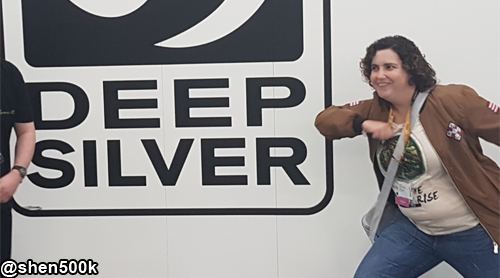
“During that time,” he continued, “At first we evaluated whether our initial plan could be carried out as expected, especially since we were using Unreal Engine 4 for the first time. And there were times we would try something but it didn’t bear fruit. We’ve had a lot happening. We have carried out a lot of adjustment in various areas, up until now. The stretch goals often incorporate a lot of things that aren’t mentioned at all in their description.”
Hideaki Morishita, the game’s executive producer and acting as live interpreter for us, sought to clarify: “To be honest, even some things that we did not put in the stretch goals, those have been some of the very positive and good things that we have been discovering. So the team and Yu-san are really trying to adjust, and take the good pieces through discovery and put them into the game.”
“So as development progressed,” we asked, “You made various discoveries compared to the original plan and found things that would improve the game, and added these as you went along?”
“That’s right,” said Suzuki, “So it has gradually grown bigger and bigger, you see…”
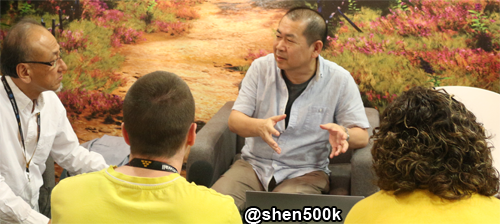
As he spoke, the director began miming a plain column or pillar above the table in front of him, indicating a narrow design view of the game’s content. “Originally it was going to be a very simple, straightforward and story-oriented Shenmue.”
With a smile he then mimed additional blocks or ideas either side of the imaginary column. “But as we have been making it, I would say ‘Maybe we should do this,’ ‘Maybe we should do that,’ ‘This would be more fun’… and so it has grown and grown.”
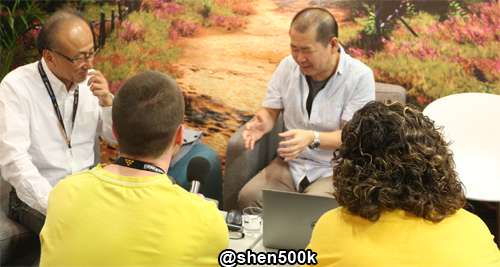
Another 500K member, Adam Clark, wanted to know if the player would be able to choose between English and Japanese voices in the game.
After confirming with Morishita that in previous Shenmue games this had been set according to the country of distribution, Suzuki told us, “I’m sorry, I cannot answer that right now. I’ll look into it once I’ve gone back, and speak with my team. Both sets of data would be needed to be able to switch between them. It’s not something I can answer immediately.”
“But you understand the wish?” Morishita asked him.
“Yes, it’s clear,” he replied.
So it appears to be a concern for the director that including audio and, we’d assume, lip synch data for both languages may be an issue in terms of disc space – a limitation that strictly governed development of the original Dreamcast games on GD-ROM. How big a limitation this proves to be with PC and PlayStation 4 remains to be seen, but we now know that a dual audio option is an ambition that Suzuki will at least explore.
Meanwhile Calvin Hall‘s question was more about the game’s visuals than audio, asking, “Will you be creating a graphical user interface that is similar to the one in Shenmue I and II?”
“I would like to do that,” Suzuki answered, “Shenmue I and II had low VGA-resolution graphics, so things like the icons were very large. If they’re too large it makes the game look like it’s designed for toddlers or grandfathers, so I’d like to make them smaller and more stylish.”
As Morishita chuckled at the director’s remarks, Suzuki opened slides on his laptop showing some of the on-screen display elements being designed, including a temporary version of the four action buttons such as the mouth icon for speaking to another character.

“It’s not finalized yet, though,” he warned, “I mean, as far as the icon designs and so-on. I haven’t decided what I’ll do there. I think this gyroscope [compass] looks cool.”
For a temporary design the display looked great to us, but most importantly for Calvin’s question it was clear they were aiming to recreate the same OSD elements familiar to fans of the previous games, and our brief preview brought home a feeling that Shenmue III itself was indeed real, tangible, and in actual development as we spoke.
Of course everyone’s definition of “what makes Shenmue Shenmue” is different, and it’s hard to argue with Mary Peña‘s urgent need to know: “Will there be a Tomato Convenience Store in Shenmue III?”
“Right now I’m thinking long and hard over whether to open up the first Tomato Mart store in China,” Suzuki mused, pointing at the wall behind us completely covered with an image of Choubu, “I’m thinking of putting it in this town.”
For clarity he pointed behind himself at a wall covered in an image of a more rural setting, “This is the first area in Shenmue III. Bailu village,” before pointing behind us again, “That one over there is the second area. It’s called Choubu. It’s quite a large area. I’m thinking I’d like to put a Tomato Mart there.”
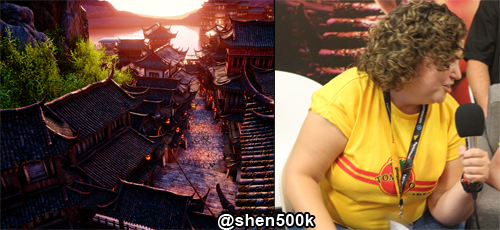
David Brown was looking for some FREE advice when he asked about the genre that Yu-san defined with Shenmue: Full Reactive Eyes Entertainment. “If other people were to make a Shenmue III type of game, in your opinion which of the FREE elements would be the most important?”
“When I was making Shenmue,” the director recalled, “The ideal I was aiming for was ‘Full Reactive.’ That was the ideal. Even now, in fact, I want to try to achieve that. The ‘Full’ part was something we devoted ourselves to, as a goal; it was one of the ideals we looked towards. But we found it difficult to achieve it in practice. With the new game, going as far as ‘Full Reactive’ is something we can try for, but I feel that it’s not easy to achieve. I would need a greater budget!”
We were really interested to hear that he considers FREE a concept that has not yet been fully realized. “Since it’s an ideal,” we asked, “Going forward in future games it’s something you’ll get closer and closer to, then?”
“Yes, I hope so,” he replied, “There are a lot of things that take higher priority. Once we’ve done all those necessary things, we’ll be able to turn our attention to it. It’s not the kind of thing you can improve across the game. It’s a nice-to-have, but not something that’s mandatory. If achieved, it would be beautiful though. Even if a game is not ‘Full Reactive,’ you can make a good game. But, what I think would be most beautiful is one that’s ‘Full Reactive.'”
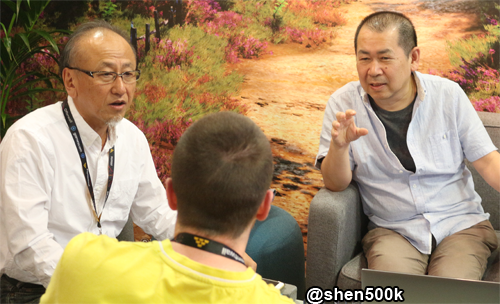
Alexander Flodén spoke for many Shenmue history buffs, including Shenmue III advisor Ryan Payton who admits to a preoccupation with this subject, when he asked if fans will ever get the chance to play the Shenmue prototype originally in development for the Sega Saturn. Specifically, how far had that version advanced before work shifted onto the Dreamcast?
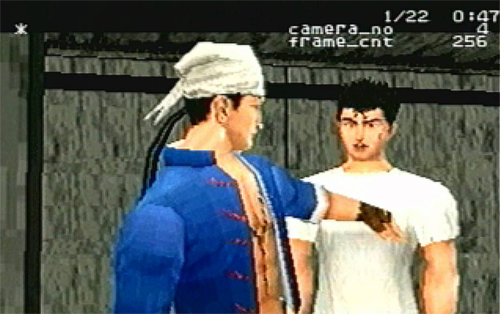
“Thirty percent,” came Suzuki’s reply.
“At 30% completion,” we checked, “It’s not likely to become available, is it?”
“No,” he confirmed, “We had progressed quite far with the visuals, but we hadn’t built the content in much depth, because it was a prototype.”
Even so, perhaps Ryan will one day lay his hands on an unlabelled disc from Sega’s vault and reveal a further glimpse of that trial run. We have a feeling the holy grail for some enthusiasts will remain a topic of speculation for some time to come.
Speaking of recurring topics of discussion in the fan community, David Pedulla put Suzuki on the spot with one of the most enduring suggestions, inspired perhaps by Shenmue’s original concept as a Virtua Fighter RPG until Akira was replaced with Ryo and it became its own adventure:
“Would you like to one day see Ryo in a Virtua Fighter game?”
“That could be difficult! I think it would be best to make a request to Sega about that,” said Yu-san.
Pressed on what he would choose if the decision was his to make, his answer may come as a surprise to longtime proponents of this crossover: “I wouldn’t do it! I don’t want to mix their worlds. I want to keep them separate.”
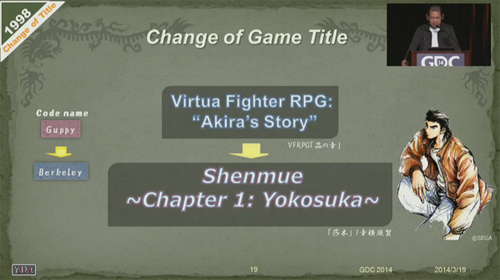
Surprises were the topic of our final question from Christos Liousas, who wondered if Suzuki had any stories about strange or unexpected places he’d encountered Shenmue fans.
Although not about a fan, Yu-san was keen to tell us a story from the time he was making Shenmue I and II.
“Back then I used to do a lot of windsurfing,” he recalled, “One time I was out windsurfing, the wind grew strong. I wasn’t able to stay on the board any longer, and I got swept along further and further.”
Becoming animated as he relived the memory, Suzuki-san mimed almost drowning while he continued, “I burst up to the surface. And I was in trouble. I was floundering around like this.”
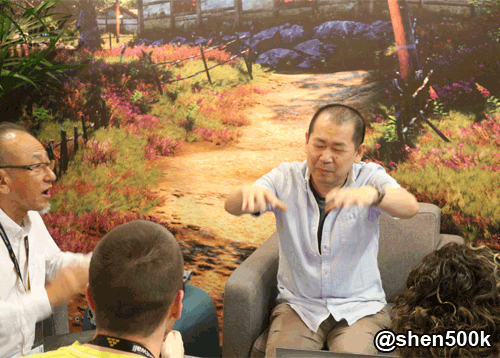
“After getting hit by wave after wave, there right before me on the shore was [Takenobu] Mitsuyoshi [main theme composer for Shenmue]. He was with his girlfriend and they were gazing out at the sea. I was in desperate straits… It seems I had interrupted Mitsuyoshi whispering sweet nothings to his girlfriend.”
Suzuki laughed, “I said to him ‘What are you doing here?!’ And he said, ‘You’re the one who crawled out of the sea!'”
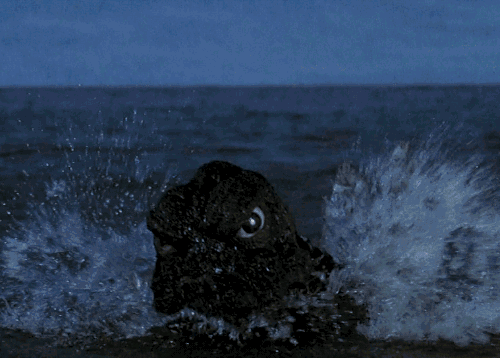
As his giggles subsided, Yu-san assured us, “True story. He’s Shenmue’s main sound composer. He composed ‘Daytona’ as well: Day-to-na!”
After we thanked the director and executive producer for taking the time to answer so many of Shenmue 500K’s questions, Suzuki-san offered to record a verbal message for the group, which he chose to do in English. We then presented him with a small token of our appreciation, following a theme started in Team Yu’s interview with co-producer Cédric Biscay the previous day. This little gift was also a callback to the MySpace campaign carried out by Nick Wisniewski and many supporters almost a decade ago.
Also, for any members who might have wondered if their eyes were deceiving them, we confirmed with Morishita-san that the following picture, included in the same project update as the recent teaser video, is indeed a tribute by Suzuki-san to the Shenmue 500K Facebook group:

For their help with arranging Shenmue 500K’s first interview with Yu Suzuki we would like to thank the whole team at Shenmue Master as well as Executive Shenmue Ambassador Ali Novin; for his renowned translation skills we owe much of the detail in this write-up to Switch at the Phantom River Stone blog; and for making Gamescom an unforgettable experience we’d also like to thank Peter, Chao, and every Shenmue fan we met in Cologne.

Thanks too of course to every Shenmue 500K member who submitted a question. We only wish we could have asked every last one, but we were lucky to get the time we did due to Ys Net’s commitment to the fan community and Deep Silver’s understanding of that unique bond.
If you haven’t yet entered our raffle to win a copy of Shenmue II signed by Suzuki-san at the event, check it out before the deadline (which falls during the next #SaveShenmueHD Tweetathon) and help a very worthy cause. Thank you and good luck!
